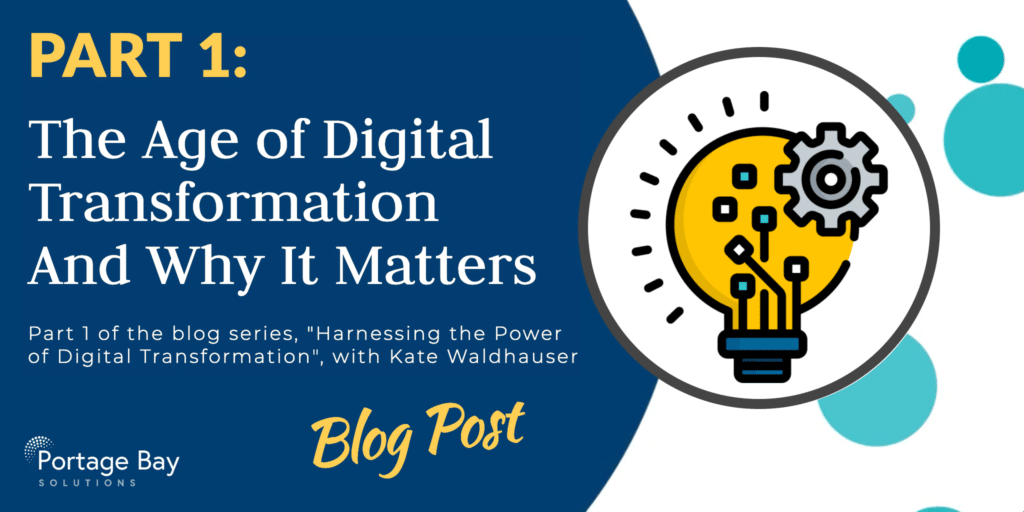Download our free Digital Transformation Tool
The age of digital disruption is upon us, and no company is immune to its effects. The phrase digital transformation is heard in every corner. Across every industry, customers and employees alike are demanding greater mobility, easier, more transparent access to information of all kinds, and flexible, pleasing user experiences. Internal operations, too, are being transformed as companies look to digitize and automate everything — the factory, the supply chain, even marketing, and sales.
www.strategyand.pwc.com
Read more from Strategy&: What’s your digital ROI? Realizing the value of digital investments
THE AGE WE LIVE IN
Well, there you have it. And I think most of us know this, but in order to gain a competitive edge in today’s business world, technological innovation is a must. In the consulting field, we work with clients from all over the map to analyze and assess their business needs and consider how to create custom solutions to solve their problems and help their businesses thrive.
It’s worth reiterating the above quote as bullet points, to illustrate again what more and more of our staff and clients are expecting and requesting:
- Greater mobility
- Easier, more transparent access to information
- Flexible, pleasing user experiences
- Digitization and automation
We all have a lot on our plates these days (often too much!), and it can be hard to keep up with these needs for expanding technology and ensuring your business is taking advantage of the options they should be. Not only is our job to stay up to date on the latest technology, but also to understand our client’s businesses so we can help ensure they are meeting their goals.
That’s why we are kicking off this summer with a new four-part blog series called Harnessing the Power of Digital Transformation, which delivers the keys to this kind of tailored, successful custom software development.
At Portage Bay, we have worked with legacy solutions, some that are at least thirty years old. Being a thirty-year-old business ourselves, we have witnessed the exponential growth in technology over time. The goal of this series is to share our expertise and insight into this topic and give you some tools you can use to help meet your long-term business goals.

WHAT IS DIGITAL TRANSFORMATION?
Digital transformation is the integration of digital technology into all areas of a business, fundamentally changing how you operate and deliver value to customers. It’s also a cultural change that requires organizations to continually challenge the status quo, experiment, and get comfortable with failure.
The Enterprisers Project
Read more from The Enterpriser’s Project: What Is Digital Transformation?
If we step back just a little bit in history – about 11 years – we have the term digital transformation first emerging, and it was described by many as a passing phenomenon. We can laugh now, because we are currently living in this digital age and we know that the technology revolution is here to stay.
Can we look into the future and anticipate the next steps we need to take to participate in this digital transformation? Not fully, but fortunately we can learn a lot from the experience of other organizations and professionals.
Gartner predicts that our world will be further driven by digital technology. In 2021, Gartner expects the physical, financial, and healthcare worlds to be digitized in such a way that at least one of seven technology empires will be participants in 20% of all our activities. Mobile apps and payments, and digital environments are already part of our daily lives.
capacity.com

Think about how often you interact with these technologies every day compared to just five years ago. How will that realization help you think ahead about the software you use and design? McKinsey Insights Reports states that B2B software is now 50% more important in a post COVID-19 environment. The demand to fix inefficiencies and streamline processes is becoming vital to the success of a modern business.
Read more from Capacity: History of Digital Transformation
CONTINUOUS IMPROVEMENT IS A REQUIREMENT, NOT A CATCH-PHRASE
When deciding to invest in custom software the questions of how much to invest, and when and where to invest, must now also keep in mind the fluidity of the digital age. We can no longer afford to “build it and forget it” (although arguably that approach was misguided to begin with). If you want to compete in today’s markets, and ensure your investment is a success, you must grasp the importance of digital transformation and make a long-term commitment to keep up with the faster rate of change that ever-advancing technology now requires.
Such commitment to continuous improvement is nothing new. Doctors, as one example, are legally required to continuously invest in themselves and their practices so their knowledge level doesn’t get stale. McKinsey informs us that fostering a continuous improvement culture can help you gain a competitive edge, and at Portage Bay we make a point to stay informed of the latest technologies so we can make effective recommendations for our clients.
PROBLEM SOLVERS CIRCLE
Coincidentally as I was preparing this post, Claris released a new program, called the Problem Solvers Circle. This program is specifically geared towards existing Claris customers that want to invest in continuous improvement of their solutions and it provides a generous discount towards achieving that. You can learn more about the program here to see if you qualify. Please fill out the form below to contact us if you would like a personalized quote.

STAY TUNED
Join me next month for the second post in this summer series, Keys to Decision Making: How to Calculate the ROI of Digital Transformation, as I dive deeper into the subject of calculating the ROI of digital transformation, and outline the tools and examples for determining the statistics to make business decisions related to digital transformation.
In the meantime, send us your thoughts and questions!
